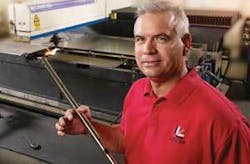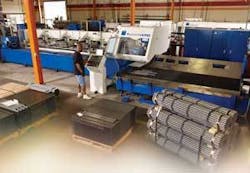Having multiple types of laser processing enables a company to provide the best solution for the customer from one location
In the 1980s Greg Claycomb, president of Lasercraft USA, was working as a tool and die maker when he met Lenny Sikora at a GM facility in Ohio. Sikora and his partner, Bill Flickinger, owned a company called Tool & Die Systems, which was located just outside of Cleveland. In 1987, Sikora was visited by Joe Schmitt, who was at the time an independent laser sales rep and who decided to call on Tool & Die Systems. Schmitt invited Sikora to a seminar on industrial laser applications. The invitation was accepted, and Sikora and Claycomb attended. Little did they know this seminar would be the first step toward a lucrative business opportunity for all of them.
Although laser technology was in its infancy in the 1980s, the four recognized its potential and decided it was time to provide northern Ohio with this promising new technology. In 1988 they purchased a laser resonator from the company represented by Joe Schmitt. With Schmitt’s commission from the resonator purchase and contributions from Claycomb, Sikora, and Flickinger-each equal to the amount of Schmitt’s commission-Lasercraft USA was founded in North Ridgeville, OH.
Located in the same building as Tool & Die Systems, Lasercraft’s goal from the start was to offer its customers diversity in laser processing. In fact, the company’s first laser machine was a hybrid system they made themselves. While the system was originally intended for cutting flat sheet, the first two customers required 3D processing capability. So, Lasercraft mounted a rotary axis to the side of the machine turning the 2D laser system into a four-axis hybrid machine. Diversity was built into this first machine, and that diversity continues to be the company’s primary strength today.
Lasercraft’s initial customers produced spun-metal parts for the lighting industry. These parts were typically processed on a 5-axis laser to cut openings, holes, and features that could not be produced with hard tooling. At the time, most companies with 5-axis capability were in the Detroit, MI, area, where automotive work came first. Lasercraft took advantage of this opportunity, providing the metal-spinning industry with a source that specialized in its type of work.
Lasercraft offers 2D, tube, and 5-axis laser processing in one location.
It wasn’t long before the partners-who for the first two years were Lasercraft’s only employees-decided to build a second laser. Purchasing the components from the same sources as the original system, the company constructed another hybrid machine with both flat-sheet and rotary capability. With this addition, Lasercraft’s sales doubled in the next year. And, the continued expansion of its customer base for 3D cutting resulted in the purchase of its first true 5-axis machine the following year.
Today, Lasercraft offers a wide range of fabricating services with a focus on laser processing. The company’s laser processing equipment has grown to include four 5-axis systems, eight flat-sheet cutters, three hybrids, two tube-cutting machines, and a laser marking system.
When asked how having such diverse laser-processing capability has impacted Lasercraft, Claycomb replies, “It allows us to provide our customers with options. Very few companies offer 2D, tube, and 5-axis laser processing in one location. Normally you would have to visit multiple companies to see the full range of laser-processing options.” He adds, “Since we are not limited by one type of laser processing we can provide the best solution for the customer, from one location. Often a customer will come to us with just one part to discuss. By the time we’ve finished the plant tour we are talking about five or six other parts that Lasercraft can produce for them-it’s all about laser-processing options.”
The flexibility resulting from possessing a variety of laser processing capabilities has many benefits. “Two dimensions is the basis of almost everything most of us cut,” says Claycomb. “But, when you can’t get where you need to be with 2D you can turn to tube cutting. And, when that isn’t enough, the 5-axis capability takes over,” he adds.
A tube Lasercraft is producing for the automotive industry is an example. A majority of the tube holes are cut on the tube-cutting machines. Several holes cannot be cut before bending due to deformation. Lasercraft was able to turn to its 5-axis capability to cut the post-bending holes, enabling the company to complete the job on-site.
Constantly striving to maintain diversity in its customer base, Lasercraft has achieved a pretty even split between its flat-sheet, 5-axis, and tube work. “Because we have options and are not limited to one type of technology, we always have something to sell,” states Claycomb. “If our tube processing is on track for our growth goals, we can switch our focus to expanding our flat-sheet business, for example,” he adds.
Since 1988, Lasercraft has grown to 48 employees. In addition to serving the metal-spinning industry, it supports the food-processing, heavy-truck, military, and other industries. Five years ago it added a second facility in Cincinnati to broaden its customer base and provide service to customers in that region.
The two facilities support each other. For example, the North Ridgeville facility is currently running production for the Cincinnati facility to free up machine time for its work related to the military’s MRAP program. Additionally, one of the 5-axis systems is being relocated to Cincinnati to better serve a local metal-spinning company that makes components for a grill manufacturer.
Competition is significantly more than at Lasercraft’s inception in 1988. Claycomb combats this by investing in productive, flexible equipment. “We operate in an environment where costs are increasing, but customers are demanding price reductions. The only way to meet these demands is to make constant improvements in process speeds to make more parts, faster,” he states.
Claycomb uses the productivity developments in his second TRUMPF TruLaser Tube (TUBEMATIC) machine as an example. “We installed our second TruLaser Tube just a few months ago and its processing speeds are substantially faster than the one we bought four years ago. Just as we strive for diversity in the services our company offers our customers, we look to suppliers, like TRUMPF, who provide a diverse line of laser processing products that are constantly being developed from an efficiency standpoint.
Lasercraft plans to increase its 2D laser cutting capability in both facilities. While future equipment additions are sure to feature the latest advancements in technology, the first machine made by Claycomb, Sikora, Flickinger, and Schmitt continues to produce parts. Claycomb says, “We keep it running because everything we have in our shop is here because of that one machine.”
James Rogowski is product manager of 2D laser machines at TRUMPF (www.us.trumpf.com).

